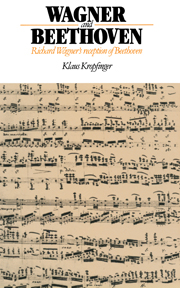Book contents
- Frontmatter
- Contents
- Preface
- Additional acknowledgements
- German and English abbreviations
- 1 Introduction
- 2 Wagner's experience of Beethoven
- 3 The Romantic background and Beethoven biography
- 4 Beethoven's role in Wagner's writings on art
- 5 Wagner's theory and construction of music drama
- 6 Wagner as Beethoven's heir
- Notes
- Bibliography
- Index of names
- Index of subjects
1 - Introduction
Published online by Cambridge University Press: 21 May 2010
- Frontmatter
- Contents
- Preface
- Additional acknowledgements
- German and English abbreviations
- 1 Introduction
- 2 Wagner's experience of Beethoven
- 3 The Romantic background and Beethoven biography
- 4 Beethoven's role in Wagner's writings on art
- 5 Wagner's theory and construction of music drama
- 6 Wagner as Beethoven's heir
- Notes
- Bibliography
- Index of names
- Index of subjects
Summary
In 1869 Wagner successfully requested a copy of Waldmüller's portrait of Beethoven, which was owned by the publishers Breitkopf & Härtel. This was not the only Beethoven portrait that Wagner possessed. For in December 1851, when he wanted a portrait of Liszt, he said that ‘so far I have only Beethoven on my wall, apart from the Nibelung sheet by Cornelius’ (SB, iv, p. 221). Since his teens, in fact, Wagner had been familiar with Beethoven's outward appearance: in My Life (p. 30) he mentions the impression which ‘Beethoven's physiognomy, as shown by lithographs of the time’ had made on him in 1827. The composer's image accompanied Wagner throughout his life, symbolizing his persistent attempts to comprehend the spiritual phenomenon that was Beethoven, to capture his likeness as both man and artist. What, then, did Beethoven look like to Wagner?
Wagner's mental image of Beethoven is an integral part of that myth of himself, or persona, at which he worked all his life and which he handed on to posterity as something binding and sacrosanct. Both during his lifetime and later on, Wagner's staunch admirers took pains to conserve this ‘self-portrait’, including those Beethovenian features to which it owes a great deal. The dyed-in-the-wool Wagnerite has always tended to accept statements by Wagner without stopping to consider the background, the context in which they were made. One illustration of this is the way Curt von Westernhagen interprets Wagner's request for a true and not an ideal picture of Beethoven.
- Type
- Chapter
- Information
- Wagner and BeethovenRichard Wagner's Reception of Beethoven, pp. 1 - 13Publisher: Cambridge University PressPrint publication year: 1991
- 1
- Cited by



